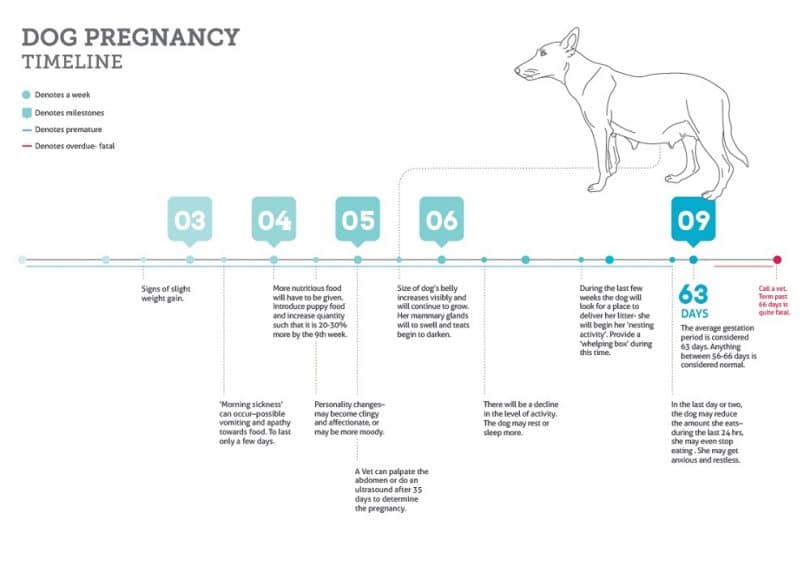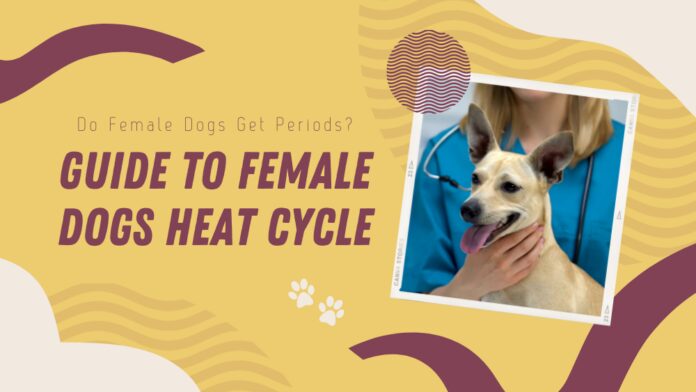All mammals go through a period of what is called estrus, which is the equivalent of the human female period. In asking do female dogs get periods, the answer is yes.
However, it’s not the same as what a human woman experiences. Many owners never consider this when they get a female dog, and they can end up with ruined carpets and unexpected litters. So what is there to know?
A female dog will have her first estrus cycle when they reach puberty. It is the stage of the reproductive cycle where the dog is capable of becoming pregnant when there is a male dog to engage in reproduction.
This period of estrus is also called “being in heat” or “in season.” On average, most dogs reach this stage at about six months of age, but this can vary according to the breed. Smaller dogs tend to have their first cycles at an earlier age.
How often does it occur? Most female dogs tend to go into heat at least twice per year, roughly every six months.
This interval can also vary depending on the breed: small dogs are capable of having a cycle at least three times a year, while giant breeds can have one once a year. During their first estrus, it is normal for a dog’s cycle to be irregular, and this can take up to two years to form a regular cycle.

How long does it last? This can also vary depending on the dog, but typically, estrus can last between two to three weeks. The most common sign before it occurs is a swollen vulva, and then there will be some vaginal discharge. Estrus is complete when the discharge completely disappears and the vulva returns to normal size.
Signs to look for
Sometimes the swelling of the vulva is not always obvious. In some cases, the vaginal discharge will occur first. This is what most dog owners will notice, especially if the estrus occurs while the dog is in the house.
Even rarer is when the discharge occurs several days after estrus has already begun. The amount of estrus that occurs varies from dog to dog, and even this can change within the dog: sometimes there will be a small amount of discharge, while others will experience heavy bleeding.
For dogs with dark coats, this discharge may not be visible at all, not until you’ve seen stains on your carpets and floors.
Over time, the vaginal discharge will change in color and appearance. It can be quite bloody at first and then changes to watery, pink discharge as the cycle progresses, usually seven to ten days into the cycle.
A female dog in heat will typically urinate more frequently or may start to develop marking behaviour. This is because during the estrus cycle, the urine contains hormones that signal the dog’s reproductive state so that potential males can find her and engage in reproduction.
This smell can travel a great distance, which is why it is never a good idea to leave your dog unattended outside when she is in heat.

When the vaginal discharge becomes watery, that is the time that the dog ovulates. This is when the dog is most fertile, and is most receptive to breeding.
However, the sperm of a male dog can survive within the vaginal tract for up to a week, so pregnancy can occur even if reproduction takes place before this stage of estrus. When pregnancy does occur, it lasts for about nine weeks. Pregnancy can be detected by palpating the uterus at about 28 to 32 days.
The best way to avoid your dog becoming pregnant, especially if you don’t have the time and/or resources to take care of a litter, is to spay your dog.
It is typically recommended that the dog be spayed before her first estrus cycle, as allowing it to occur increases her chances of becoming pregnant. It can be difficult to predict when the first cycle will occur, so most veterinarians opt to conduct the surgery when the dog is roughly six to seven months old.
There are myths saying that dogs should be allowed to have their first estrus or to have a litter of puppies before spaying because this will make them friendlier. However, this is entirely false, and having a litter will not change the dog’s disposition.
In fact, having a litter at a young age can be quite detrimental on a young dog. It’s best to spay as soon as possible. Unlike humans, dogs do not experience menopause, which is defined as the halting of monthly cycles.
Since dogs do not have a monthly cycle, then they cannot experience this condition. They can even become pregnant at old age, but this can create complications that can jeopardize the health of the dog.
Complications that occur during Estrus
When your dog is in heat, you may believe that the worst that can happen is having to clean your floors. However, there are other complications that can occur.

Many of these can be avoided if you get your dog spayed.
- Pregnancy: if you’re not financially prepared to take care of a litter of puppies, then a pregnant dog will certainly be a financial burden. This can also be more difficult for senior dogs who have underlying conditions that can make the pregnancy life-threatening.
- False pregnancy: this can occur at any age in a dog, whether she has mated or not. This is when progesterone is secreted by the corpus luteum and then does not regress when estrus should be over. Instead, the dog starts to show signs of pregnancy, such as nesting behaviour, mothering behaviour and milk production. This condition usually resolves itself within two to three weeks, and treatment may need to be provided in order to relieve discomfort.
- Pyometra: this is the accumulation of pus in the uterine cavity. Elevations in progesterone can cause this to occur; it causes the lining to become thick and lush in preparation for pregnancy. When pregnancy doesn’t occur, bacteria are free to enter the uterus and cause infections. If left untreated, the condition can become lethal. Medical therapy may be recommended, but the best treatment is to spay.
- Mammary cancer: this is common in dogs that have not been spayed. It can occur in any of the mammary glands, or as multiple cancers in the glands and surrounding lymph nodes.
If you notice that your dog has become suddenly lethargic, is drinking more water than usual and doesn’t want to eat, then it is time to take her to the vet. This is even more important for unspayed senior dogs, as it could be a sign of pyometra, and it can result in death if left untreated.
What to do when your dog is in heat
There are some vitals steps that you should take if your dog is ever in heat.

These suggestions will not only help to keep you safe, but will make your dog’s life more comfortable, especially if you choose not to spay your dog.
- Never let your dog go outside alone. When your dog is in heat, male dogs can smell it from miles away and will come running to investigate. If your dog does need to go outside, go with her, as it can be unpredictable when a male dog may show up. Watching from inside may not give you enough time to stop the act before it starts. Keeping your dog on a leash is also recommended so that you can keep her away from male dogs.
- Don’t engage in off-leash walks. It makes it easier for other male dogs to find you if you’re walking around the neighborhood. Providing walks while she is in heat is definitely recommended, but it’s important to be prepared if strange dogs wander up. Even if your dog has good recall, a dog will always follow its natural instincts, and is more likely to consider mating over appeasing your need for obedience.
- Provide extra attention to your dog when she is heat. There are not only physical changes, but mental chances as well. Provide play, brush your dog, take her on a walk, and give her more attention than usual. This will help to keep your dog more calm and will help her to get through estrus with more confidence.
- Avoid any training or taking your dog to dog shows. Any events where other dogs will be involved are definitely not recommended. The scent will agitate male dogs, and they will disrupt everything that is going on around them.
Dog owners are very serious about these events, as they’ve worked so hard for a long time, and to have everything ruined by a dog in heat can be frustrating. If you do attend these events and estrus occurs unexpectedly, remove your dog from the premises immediately. The event coordinators may even be able to provide you with a refund. - Provide a balance between exercise and rest. Different dogs react differently when they go into heat. Some may experience fatigue all day, while others become restless. Taking careful observation of your dog’s behavior can provide you with the right clues that you need to take appropriate and immediate action. What’s most important is to keep your dog comfortable.
If your dog is tired, let her sleep, but if she’s feeling restless, there are plenty of things you can do to help her calm down again. Provide lots of exercise to wear her out, whether it’s long walks or a good game of fetch. When you just don’t have the energy, provide a lot of chew toys and treats for her to take her frustration out on. Puzzle toys filled with treats can also keep her busy, and provides her with some mental stimulation as a distraction. - Hide the trail back home from male dogs. They can easily track the scent back to your home, and you could end up with a yard of male dogs the next day, waiting for your female dog to come outside. The best way to break up the scent is to drive your dog to the park or their favourite walking spot, and then to drive back home. That way, male dogs won’t be able to track the scent all the way back to your home.
- Add menthol to the end of her tail. Menthol is a strong, natural oil that won’t hurt your dog’s skin in any way. It can do a great job of masking the scent of your female dog’s estrus. It can help for male dogs that are at a distance, but if they get too close, this method will no longer work. Menthol is also good for keeping fleas away from your dog, so you can kill two birds with one stone.
- Using doggie pants can certainly help to not only keep the scent at bay, but it will also keep your floors and carpets clean. The only downside to this is that they won’t prevent a male dog from mounting your dog, so care should still be exercised when you take your dog outside.
Talking with your vet can help to learn some ideas of what you can do when your dog is in heat.
Even if it’s not a serious illness, your veterinarian can be a fountain of information for helping to keep your dog comfortable and prevent her from becoming pregnant. You can even discuss the options of spaying your dog, and when the right time should be.

Female dogs going into heat can be a trying time for everyone involved, and then some. It can be something of a hassle to take care of your dog doing these trying times, and it can put your dog at risk for conditions that can jeopardize your life.
If you have no intention of breeding your dog and to cut back on the overpopulation of dogs in shelters, it’s always best that you consider spaying as the best option for making your dog’s life a lot easier.




